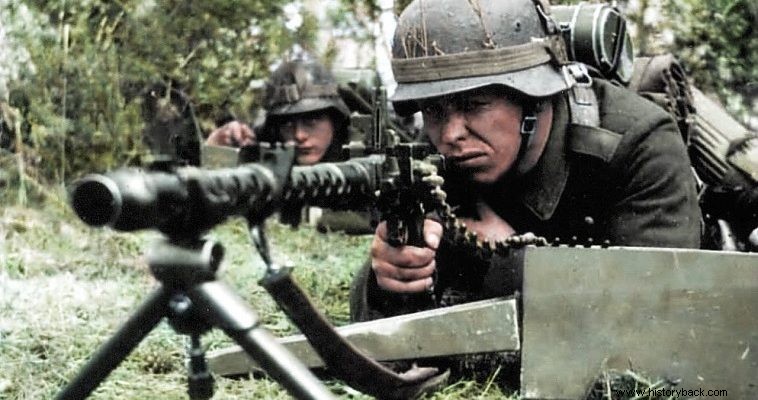
The German infantry platoon consisted of four battle groups, a command group and a light mortar group. The squad consisted of the chief platoon leader, who usually held the rank of sergeant or corporal, and nine men, one of whom was the platoon leader's assistant.
The squad leader was armed with an MP-38 and later MP-40 submachine gun. He carried six 32-round magazines, binoculars, a wire cutter, a compass and a flashlight. The team leader commanded the team, directed the fire of his men and especially the light machine gun, which was its main weapon. He was also responsible for the training and maintenance of the armament of his men, as well as for its supply with ammunition.
The team was divided into two halves. The semi-machine gun team consisted of three men, a machine gunner and two assistants. The machine gunner also carried a pistol, a shovel and a flashlight. The machine gun was of the MG 34 or later MG 42 type. The machine gun carried a 50-round drum magazine or the corresponding bands.
The first mate also carried a pistol, four magazines or bands for the machine gun (200 rounds), a box of 300 extra rounds and a hatchet and a spare barrel for the machine gun. The second assistant brought a rifle, another spare barrel for the machine gun, a slingshot and two boxes of 300 rounds each.
The machine gunner was responsible for the handling, but also the maintenance of his machine gun. The first assistant was always at the machine gunner's side ensuring the supply of the weapon with ammunition, changing the barrel in cases of overheating, but also minor repairs. The second assistant was primarily responsible for feeding the machine gun with ammunition.
The second half-team, known as the rifle, support or maneuver half-team, consisted of six men and was commanded by the assistant team leader. Each man carried his individual rifle and the corresponding ammunition, slingshot and grenades. Depending on the mission, they were equipped with smoke grenades, explosive charges, additional ammunition for themselves and the machine gun or even tripods for this weapon.
The mission of the semi-group of riflemen was, taking advantage of the machine gun fire, to approach the enemy positions and destroy the enemy either by a direct attack or by a circular maneuver. The assistant squad leader also acted as a liaison with the commander of the platoon concerned and with the other squads.
The battle group could be deployed in man-by-man phalanx, in dense formation, in strafing or line formation, and staggered to the right or left. The phalanx per man was mainly a formation of access, but also of passage through difficult terrain or a populated area. With the machine gun in front, the team could directly engage enemy resistance, while the riflemen could control the flanks of their small phalanx.
The squad leader marched first followed by the machine gun half team with the machine gunner immediately behind him so that, in case of need, he could fire against any enemy resistance. Next came the semi-platoon of riflemen with the assistant squad leader marching last.
In dense formation the team marched in threes with the machine gun half-team leading the way. The machine gunner marched to the right or left, depending on the tactical situation, always having the team leader by his side who directed his fire. The riflemen followed in two groups, with the assistant team leader marching opposite the team leader, as the tail.
This formation was used to carry out an attack and gave depth to the group and therefore striking power. In an acrobolism formation (line) the team could move directly from the man-by-man phalanx formation. The team leader led by recognizing the terrain .
Just behind him was the machine gun half squad and three riflemen covered each wing with the assistant squad leader covering one of the two ends of the formation. With this formation, the group could fire at the enemy with all its weapons.
Escalation of the group to the right or left was a formation to cover the respective flank. The machine gun half-team formed one side of the formation with the other half-team moving staggered in the chosen direction. In this formation the team was also able to fire almost all of its weapons against the enemy, deploying, in minimal time in line.
The only difference from the normal line formation was that the machine gun was positioned on one of the two sides and not in the center of the formation.
These formations were the basic ones but could be changed according to the tactical conditions. Usually males were deployed at a distance of 3.5-4 m from each other during movement. During the defense the team was developing, again based on the regular conditions , with the machine gun half-team forming the backbone of the defense and the riflemen covering it.
Initially, the battle group had no anti-tank weapons. However, anti-tank rifles, or later portable anti-tank launchers, hollow charges and mines could be made available on occasion.
The German battle group, as the war progressed, evolved accordingly. In 1943 the team now consisted of nine men.
In some cases, a second machine gun was made available - mainly to Grenadier Panzer battle groups - while "assault" battle groups were formed with their men equipped only with sub-machine guns and grenades. The riflemen were also equipped with MP 43 and StG 44 assault rifles. In these cases the distinction between machine-gun and riflemen's half-squads was abolished and the group, nine men strong, consisted of two fire (machine-gun) half-squads and a fighting half-squad.
